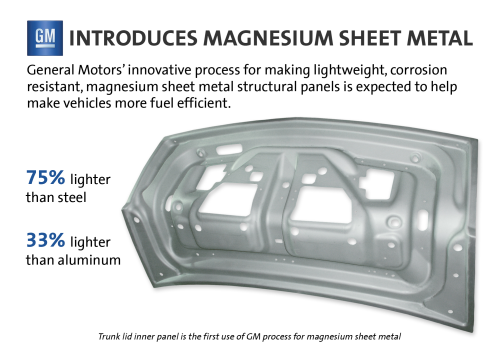
GM wants to expand its use of low-mass parts on vehicles around the world and will pursue licensing opportunities related to this breakthrough technology. The goal is for suppliers to be able to use the process to provide significant amounts of magnesium sheet that will trim pounds from vehicle mass.
The use of magnesium, which weighs 33 percent less than aluminum, 60 percent less than titanium, and 75 percent less than steel, will help customers save money at the gas pump, as will more efficient conventional engines and electric powertrains.
Until now, automakers have struggled to make reliably strong and non-corroding magnesium sheet metal panels using traditional panel forming methods, according to GM. GM’s patented process turns up the heat on magnesium to 450 degrees Celsius (842 degrees Fahrenheit), allowing the material to be molded into precise, rigid shapes.
Using this process, GM developed a production-ready magnesium rear deck lid inner panel that withstood 77,000 robotic slams and 250-kilogram impact drops without any issues.
Die-cast magnesium has been used in a variety of parts ranging from steering wheels to engine cradles, but GM is the first to use thermal-formed magnesium sheet metal in structural applications, and it expects magnesium sheet applications to grow with additional materials and process improvements targeted at reducing cost.
“This innovative use of magnesium is just one example of how GM is leveraging breakthrough technologies that will benefit our customers around the globe,” said Jon Lauckner, GM chief technology officer and vice president of Global Research & Development. “Using high-strength lightweight materials such as magnesium and aluminum is one of the most effective ways to improve vehicle fuel economy and driving performance.”
GM R&D recently announced an industry-first welding technology for aluminum, which is expected to enable more use of the metal on future vehicles.
The United States Automotive Materials Partnership estimates that by 2020, 350 pounds of magnesium will replace 500 pounds of steel and 130 pounds of aluminum per vehicle, an overall weight reduction of 15 percent. This weight savings would lead to a fuel savings of 9 percent to 12 percent. On the production ready rear deck lid inner panel, for instance, GM can remove 1 kilogram (2.2 pounds) of weight compared to an aluminum deck lid inner panel.
Automakers also have struggled to make magnesium corrosion resistant. GM’s proprietary treatment for thermal-formed magnesium resisted 10 consecutive weeks of 24-hour environmental tests involving salt spray, 100 percent humidity and extreme temperatures.
The complete release is available online.


